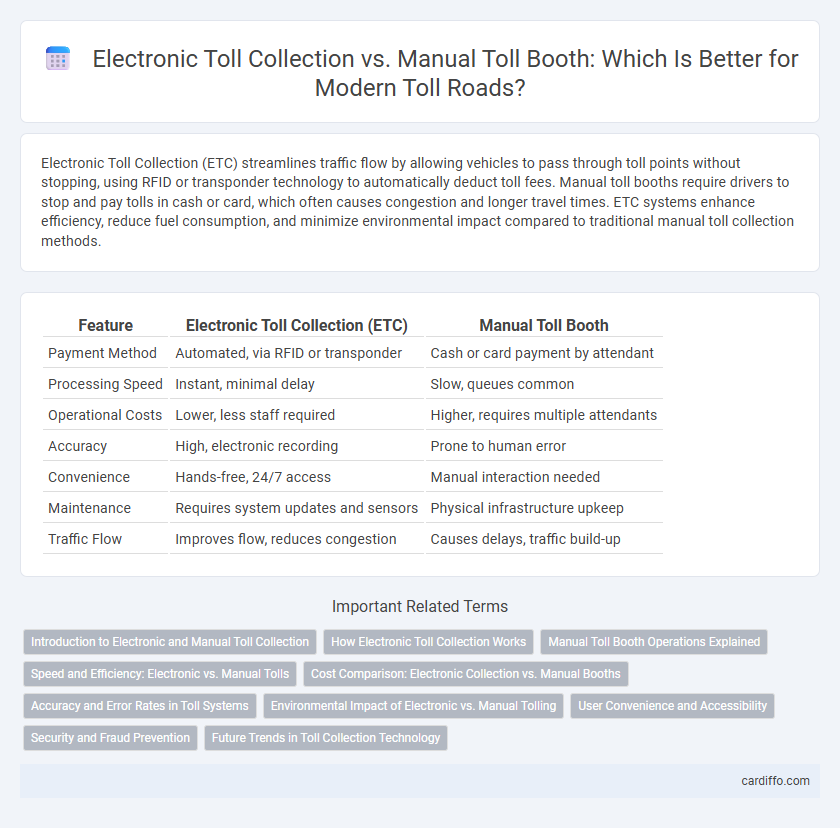Electronic Toll Collection (ETC) streamlines traffic flow by allowing vehicles to pass through toll points without stopping, using RFID or transponder technology to automatically deduct toll fees. Manual toll booths require drivers to stop and pay tolls in cash or card, which often causes congestion and longer travel times. ETC systems enhance efficiency, reduce fuel consumption, and minimize environmental impact compared to traditional manual toll collection methods.
Table of Comparison
| Feature | Electronic Toll Collection (ETC) | Manual Toll Booth |
|---|---|---|
| Payment Method | Automated, via RFID or transponder | Cash or card payment by attendant |
| Processing Speed | Instant, minimal delay | Slow, queues common |
| Operational Costs | Lower, less staff required | Higher, requires multiple attendants |
| Accuracy | High, electronic recording | Prone to human error |
| Convenience | Hands-free, 24/7 access | Manual interaction needed |
| Maintenance | Requires system updates and sensors | Physical infrastructure upkeep |
| Traffic Flow | Improves flow, reduces congestion | Causes delays, traffic build-up |
Introduction to Electronic and Manual Toll Collection
Electronic Toll Collection (ETC) systems use automated technology such as RFID transponders and license plate recognition cameras to enable vehicles to pay tolls without stopping, significantly reducing traffic congestion and improving travel efficiency. Manual Toll Booths require drivers to stop and pay tolls directly to a cashier or through a machine, causing delays and increasing the risk of human error and traffic backups. ETC offers seamless, real-time toll processing that enhances revenue collection accuracy and lowers operational costs compared to traditional manual toll collection methods.
How Electronic Toll Collection Works
Electronic Toll Collection (ETC) uses radio-frequency identification (RFID) or Automatic Number Plate Recognition (ANPR) technology to automatically identify and charge vehicles as they pass through toll points, eliminating the need for stopping. Vehicles are equipped with transponders or tags linked to an account that securely deducts the toll fee in real-time, enhancing traffic flow and reducing congestion. This system relies on sensors and cameras to capture vehicle information, ensuring accurate billing and seamless toll road management.
Manual Toll Booth Operations Explained
Manual toll booth operations involve vehicles stopping at designated lanes to pay toll fees directly to an attendant or via coins and cash collected in a toll basket. This traditional method requires physical infrastructure and staff, leading to increased traffic congestion and longer wait times during peak hours. Despite advancements in electronic toll collection, manual toll booths remain essential in areas lacking digital payment systems or for drivers without transponders.
Speed and Efficiency: Electronic vs. Manual Tolls
Electronic Toll Collection (ETC) systems significantly enhance speed and efficiency by enabling vehicles to pass through toll points without stopping, reducing congestion and wait times. Manual toll booths require each vehicle to halt for cash or card transactions, causing delays and increased fuel consumption. The seamless data processing in ETC minimizes human error, streamlining traffic flow and improving overall road network efficiency.
Cost Comparison: Electronic Collection vs. Manual Booths
Electronic toll collection systems drastically reduce operational costs by minimizing labor expenses and streamlining vehicle processing, leading to lower toll collection fees. Manual toll booths incur higher costs due to staffing requirements, cash handling, and slower transaction times, which increase overall maintenance and administrative expenses. The efficiency of electronic toll collection supports scalability and cost savings that manual toll booths cannot match, making it a more economical solution for toll operators.
Accuracy and Error Rates in Toll Systems
Electronic Toll Collection (ETC) systems significantly reduce error rates compared to manual toll booths by automating vehicle identification and payment processes through RFID or license plate recognition technologies. Manual toll booths are more prone to human errors and inconsistencies in fee collection, resulting in higher dispute rates and slower transaction times. The increased accuracy of ETC systems enhances revenue assurance and minimizes traffic delays, promoting smoother toll road operations.
Environmental Impact of Electronic vs. Manual Tolling
Electronic toll collection significantly reduces vehicular emissions by eliminating the need for vehicles to stop or slow down at toll booths, resulting in smoother traffic flow and lower fuel consumption. Manual toll booths cause increased idling and acceleration, contributing to higher carbon dioxide and pollutant emissions in toll plaza areas. Studies indicate that electronic tolling systems can cut greenhouse gas emissions by up to 30% compared to traditional manual toll collection methods.
User Convenience and Accessibility
Electronic Toll Collection (ETC) significantly enhances user convenience by enabling seamless, contactless payments, reducing wait times and traffic congestion compared to manual toll booths. ETC systems improve accessibility for all vehicle types and allow drivers to pass through toll points without stopping, benefiting users with disabilities or those unfamiliar with manual payment procedures. Manual toll booths often require cash or card handling and physical interaction, creating longer delays and accessibility challenges for diverse road users.
Security and Fraud Prevention
Electronic Toll Collection systems enhance security by utilizing encrypted RFID technology and automated license plate recognition, reducing human error and minimizing opportunities for fraudulent activities compared to manual toll booths. Automated data processing in ETC enables real-time detection of suspicious transactions and quick responses to potential fraud, which manual toll collections lack due to reliance on human operators. The elimination of cash handling in ETC further diminishes risks of theft, counterfeit currency, and bribery prevalent in traditional manual toll operations.
Future Trends in Toll Collection Technology
Electronic Toll Collection (ETC) systems are revolutionizing toll road operations by utilizing RFID and ANPR technologies for seamless vehicle identification and automated payments. Future trends include integration with smart cities, AI-driven traffic management, and blockchain-based payment security to enhance efficiency and reduce congestion. Manual toll booths are increasingly being phased out in favor of contactless solutions that support real-time data analytics and eco-friendly, cashless transactions.
Electronic Toll Collection vs Manual Toll Booth Infographic

 cardiffo.com
cardiffo.com